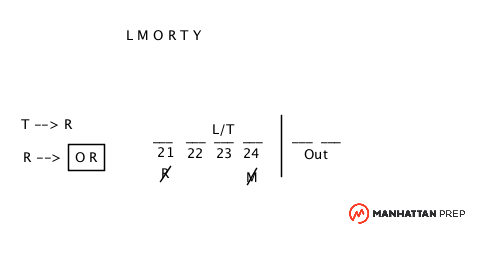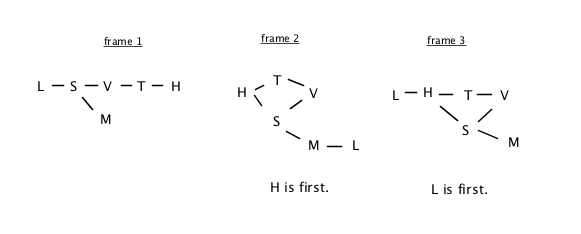Yikes. Sorry, I don't know what happened with that original post. Unfortunately, I don't have access to that image or have the ability to post a new image, but I can try to describe the diagram setup in this godforsaken ASCII environment.

======== HERE ARE THE EVENTUAL THREE FRAMES ========
T in 23 (finished frame)
O R T L/Y <> M Y/L
T in 24 (finished frame)
O R L T <> Y M
T is OUT (finished frame)
(
......O
.....)
__ __ L __ <> T __
....... (Y, M: 21 or 22, R -> OR)
========== BELOW IS HOW WE GOT THERE =============
What kind of game? How many people / how many spots?From 6 people, 4 are being assigned to four spots. The other two will be unassigned, so we need 2 out spots.
L M O R T Y
___ ___ ___ ___ <> __ __
21
...22
...23
...24
........out
There are conditional rules dealing with whether or not people are assigned, so part of this game is In/Out Grouping.
Other rules use ordering terms like "prior to Ryan's", so part of this game is Ordering.
Rule 1: goes right on the diagram
___ ___
L/T ___ <> __ __
21
...22
...23
...24
........out
Rule 2:
...................M --> 21 or 22
~21 and ~22 --> ~M
Rule 3:
...T --> R
~R --> ~T
Does this create an "at least" placeholder for the IN or OUT group?
No, they might both be in, both be out, or a mix.
Rule 4:
.........R --> [OR]
~[OR] ---> ~R
Anyone mentioned in more than one rule? Anyone never mentioned?Y is never mentioned. We'll circle Y in our roster of characters.
R is in a couple and T is in a couple. Let's think about how those rules interact.
R's rules actually chain together.
rule 3: If T is in, R is in.
rule 4:
.............if R is in, then O is immediately before
So if T is in, then we have to have an OR chunk.
That makes me want to frame this game, even if it's five frames.
If I assign T to each of the four IN spots, I'll probably always know stuff about where the OR chunk could go. And I'll probably know whether M has a 21 or 22 spot available, and whether L or T is going 23.
So if you're good at whipping up quick frames, this game looks to be solvable in five frames (put T in 21, 22, 23, 24, and OUT)
T in 21 (so L is in 23)
T ___ L ___ <> __ __
Where would the OR chunk go? There isn't a two-spot opening. This frame dies. T can't be in 21.
T in 22 (so L is in 23)
___ T L ___ <> __ __
Where would the OR chunk go? There isn't a two-spot opening. This frame dies. T can't be in 22.
T in 23
___ ___ T ___ <> __ __
OR would have to go in 21 and 22
O R T ___ <> __ __
M doesn't have a spot anymore.
O R T ___ <> M __
L and Y are left, and neither has a rule that would make us care where we place them.
T in 23 (finished frame)
O R T L/Y <> M Y/L
T in 24 (so L is in 23)
__ __ L T <> __ __
Where would OR go? In 21 and 22.
O R L T <> __ __
So the other two are OUT.
T in 24 (finished frame)
O R L T <> Y M
T is OUT (so L is 23)
__ __ L __ <> T __
Does this tell us anything about the OR chunk rule? Seemingly no, because we don't know whether R is in yet. We could sub-frame this one (do one with R in and one with R out).
Or we could notice the "OUT column overflow inference" we get from rule 4.
If O is out, then R also has to be out. (we couldn't have R in and O out!)
Since we wouldn't have room to put O and R in the out column, we know that O
can't be out.
T is OUT (finished frame)
(
......O
.....)
__ __ L __ <> T __
....... (Y, M: 21 or 22, R -> OR)







